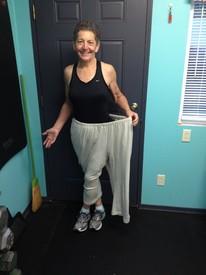How Accurate is a Hand-held Body Fat Analyser?

flaminica
Posts: 304 Member
This is a rant. I just got back from the gym and I'm feeling down. Help me out with some reassurance.
When I started training at my new gym back in October the head trainer used a hand-held device like this one and told me my body fat percentage was 39% He tapped the machine and said "I think that's too high. You don't look that. I think you're about 37%."
Fast forward three months. I've been strength-training three hours a week. I've lost five pounds, my clothes are fitting more loosely, my family say I look noticeably leaner, and I've got new muscle definition. The trainer had me try the device again. 40.7% body fat. I walked home, resisted the urge to cry and looked up calculators on Google. This test gave me an estimate of 33%.
Here's a couple of recent photos, one from Christmas and the other from Thanksgiving. Does this look like 40% body fat? Am I in denial? Is this device full of %$#*? Should I demand a second test with a different machine?

When I started training at my new gym back in October the head trainer used a hand-held device like this one and told me my body fat percentage was 39% He tapped the machine and said "I think that's too high. You don't look that. I think you're about 37%."
Fast forward three months. I've been strength-training three hours a week. I've lost five pounds, my clothes are fitting more loosely, my family say I look noticeably leaner, and I've got new muscle definition. The trainer had me try the device again. 40.7% body fat. I walked home, resisted the urge to cry and looked up calculators on Google. This test gave me an estimate of 33%.
Here's a couple of recent photos, one from Christmas and the other from Thanksgiving. Does this look like 40% body fat? Am I in denial? Is this device full of %$#*? Should I demand a second test with a different machine?

0
Replies
-
Congrats on your progress! All handheld devices or BF scales are completely unreliable.1
-
The short answer is: It's not. Hand-held devices and body fat scales use bioelectric impedance to measure body fat % and this is a very inaccurate method. A set of body calipers will give you a much more accurate measure of BF%.1
-
Handheld BIA devices are, IMO, completely worthless.
As far as your pictures go, who knows? You're completely clothed in both, so I/we can't really tell much.4 -
Electrical impedance devices such as that are not accurate. I also have such a device in my Omron scale. I also measured a higher bf% on my second measurement after losing my first few pounds of weight.
An actually more accurate method of measuring body fat is to use calipers, and if you care to spend that money you can.
And, I think you're looking great and should continue your strength training.1 -
You look great and healthy. Don't get hung up on BF%. Short of doing a postmortem, no BF determination methods is very reliable on an individual basis. Most aren't even reliably comparable over time in order to see changes in BF. Judge yourself based on how you see yourself progressing (you're doing great--you've lost weight, your clothes fit looser, you see muscle definition.)
If you want to read more about BF determination methods, James Krieger has a great series on them here:
Part 1
Part 2 (underwater/hydrostatic weighing)
Part 3 (Bod Pod)
Part 4 (bioelectrical impediance/BIA)
Part 5 (skinfolds/calipers)
Part 6 (DEXA)
4 -
Thanks all for the feedback. I'll ask my GP about more accurate options at my next checkup. For now I'll trust my (shrinking) gut and your well-informed opinions.2
-
They aren't known to be accurate & there's not really any way to tell how you are built from the photos you posted; but we have one and for me the number it gives correlates with what i get from calipers or the online calculators that use measurements, and comparing my body to images of different bodyfat %. So my experience has been that they work as well as other low tech methods.
Try the online calculators - get a measuring tape, measure all your parts, input the numbers and see what that gives you.1 -
There is no perfect method of BF measurement.
DXA and hydrodtatic testing are considered the best but even they, depending on who you ask, have an estimated 2-10% individual error rate; a 5% error rate is probably average.
The problem w/these methods, apart from the techical issues, is that they typically cost $40 (or more) per measurement. DXA gives more varied and detailed info for the price but I precer hydro because it gives me better readings. LOL!
Bioelectrial devices are the least reliable; variation in water weight is the primary measurement problem. Ironically, the higher your water weight, the lower your BF reading will be.
I have one and it routinely gives me BF readings 4-7% higher than I've gotten w/hydrostatic testing. I've also gotten DXA measurements 4-5% higher than hydrostatic.
That said, if you use the same bioelectric device under the same conditions (eg., in the morning after you use the bathroom), you can probably rely on the "trend" of the measurements over time.
Even if the individual measurements are off, that inaccuracy is controlled by taking mutiple measurements w/the same device under comparable conditions.
Tape measurement tables also give me a higher reading as compared w/hydrostatic but, it's a cheap and reasonable alternative if you lack any other means of measurement. Just try to make the measurements as accurate as possible.
1 -
A good one can read +- 5%.0
-
Bioelectrial devices are the least reliable; variation in water weight is the primary measurement problem. Ironically, the higher your water weight, the lower your BF reading will be.
I have one and it routinely gives me BF readings 4-7% higher than I've gotten w/hydrostatic testing. I've also gotten DXA measurements 4-5% higher than hydrostatic.
Ok this factoid jumped out at me because the trainer did the test after a one hour workout, but before I had lunch. Not being much of a breakfast person, I'd had nothing to eat but an apple and a lot of coffee. (Not ideal I know.) Point being I was probably very dehydrated at the time. The initial BF test (the one that the head trainer admitted he thought was too high) was also done after a workout but before eating or properly rehydrating, and he cited dehydration at the time for giving an inaccurate result.
The other wild-card factor I question is whether loose skin will exaggerate the result. My total loss was 110lbs (from 230 down to 120). I'm probably carrying about ten extra pounds of arm and belly flaps. That's why I don't have any bikini photos. I've checked out those photos of what the human body looks like at various BF percentages and every representation of a 40% BF body looks like I did back about sixty pounds ago.
I've checked out those photos of what the human body looks like at various BF percentages and every representation of a 40% BF body looks like I did back about sixty pounds ago.
So... Maybe at the next check-in I should insist on a BF test before the workout. Not that I'm going to pay much mind to it, as the consensus seems to be that the device is rubbish.1 -
10 points to Slytherin!2
-
Yes, this machene is always shows higher than really u are. My fat % was 18% by caliper, while the impendance determine as 32%. So don;t cry! IT's machene stupid2
-
MelanieCN77 wrote: »10 points to Slytherin!
Well spotted. Clearly I need to worry less about BF numbers and remind myself that I'm buying in Girl's sizes. 0
0
This discussion has been closed.
Categories
- All Categories
- 1.4M Health, Wellness and Goals
- 398.1K Introduce Yourself
- 44.7K Getting Started
- 261K Health and Weight Loss
- 176.4K Food and Nutrition
- 47.7K Recipes
- 233K Fitness and Exercise
- 462 Sleep, Mindfulness and Overall Wellness
- 6.5K Goal: Maintaining Weight
- 8.7K Goal: Gaining Weight and Body Building
- 153.5K Motivation and Support
- 8.4K Challenges
- 1.4K Debate Club
- 96.5K Chit-Chat
- 2.6K Fun and Games
- 4.8K MyFitnessPal Information
- 12 News and Announcements
- 21 MyFitnessPal Academy
- 1.5K Feature Suggestions and Ideas
- 3.2K MyFitnessPal Tech Support Questions








